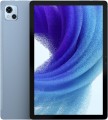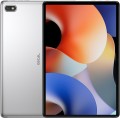Screen to body ratio
This parameter shows how much of the tablet's front panel area is on the display. The higher the display/body ratio, the thinner the frames and the more compact the tablet (with the same diagonal), the more elegant and aesthetically pleasing it looks. This indicator is also important when holding the tablet with both hands at once (for example, in games):
thin frames or even
frameless models allow you to reach further with your fingers without removing your hands from the device.
TÜV Rheinland certificate
TÜV Rheinland certified for reduced screen emissions and good eye protection.
Graphics card
Model of the graphics card installed in the tablet. The graphics card in such devices is not a separate device, but part of the processor; however, she still has a clear specialization and is responsible for graphics.
Accordingly, the graphics capabilities of the tablet directly depend on the characteristics of the video accelerator. Theoretically, knowing the name, you can find detailed specifications of a graphics card, reviews, test results and other information and evaluate how it suits you. At the same time, in most cases there is no need to delve into such details — all system components, including the graphics card, are usually selected in such a way as to correspond to the general class of the tablet and the capabilities necessary for this class.
Storage capacity
The volume of the tablet's own built-in storage. The larger it is, the more information (programs, games, movies, photos, etc.) can be stored on the tablet without resorting to removable media, rewriting to other devices, etc. At the same time, the amount of built-in memory significantly affects the cost. Therefore, some models are available in several versions, differing only in the capacity of the drive. And the variety of built-in memory is quite wide: from
16 GB to
1024 GB with a 2-fold increase (
32 GB,
64 GB,
128 GB,
256 GB,
512 GB).
Note that this paragraph indicates the total amount of internal memory. The operating system and default programs also take up space in it; therefore, the volume of the drive actually available to the user will inevitably be less than the total.
Many tablets allow you to add memory cards to the built-in drive (see below). Such cards are relatively inexpensive, but they are much slower, and the ability to work with them may be limited by the manufacturer — for example, not all tablets with this function allow installing applications on removable media.
AnTuTu Benchmark
The result shown by a device when undergoing a performance test (benchmark) in the AnTuTu Benchmark.
AnTuTu Benchmark is a comprehensive test designed specifically for mobile devices, primarily smartphones and tablets. It evaluates the performance of the processor, memory, graphics, and input/output systems, providing a clear impression of the system's capabilities. The better the performance, the higher the score. According to AnTuTu, top models are those that score more than 500,000 points.
As with any benchmark, this test does not provide absolute precision; for more details on measurement inaccuracies, see the "3DMark Gamer's Benchmark" section.
Connections
—
microUSB. A smaller version of the USB connector, widely used in modern tablets as a universal interface. MicroUSB is used primarily to charge the battery and connect the device to a computer, and with USB OTG support, flash drives and other accessories are connected to it (of course, an adapter is required to work with a full-size USB plug). This connector is gradually being replaced by a more convenient and advanced USB-C (see below), but microUSB is still very far away from the complete disappearance.
—
USB-C.It has similar dimensions to microUSB (see above) and replaced it, but differs in the design of the connector – it is symmetrical, which allows you to connect the plug to either side. In terms of application, this interface is also similar to microUSB, with the adjustment that USB-C often supports the advanced USB 3.2 gen2 standard, which provides speeds up to 10 Gbps. In addition, it is easier to implement fast charging through such a connector — some of the charging technologies were originally created for USB-C.
—
USB4. A high-speed revision of the USB interface introduced in 2019. It uses only symmetrical USB-C connectors and does not have its own data format — instead, such a connection is used to transfer information according to several standards at once: USB 3.2 and DisplayPort as mandatory, as well as PCI-E as an option. Another feature
...is that USB4 is based on the Thunderbolt protocol. It is also worth noting that this USB revision allows connecting devices in a daisy chain and by default supports Power Delivery technology, which allows you to optimize the process of charging external gadgets (provided that they also implement this technology).
The maximum data transfer rate for such a connector should be at least 10 Gbps, in fact, options for 20 Gbps and even 40 Gbps are often found (depending on the technologies and standards supported by a particular port). At the same time, the USB4 inputs are quite compatible with the peripherals of the USB-C connector.
— USB 2.0. Full size USB port 2.0 compliant. Such a port allows you to connect ordinary USB peripherals to the tablet — for example, flash drives or keyboards; however, due to its large size, it is rare, mainly in business models and in "hybrids" equipped with docking stations (in such cases, the port can be placed on the docking station). Version 2.0 supports data transfer rates up to 480 Mbps and is still quite popular, although it is gradually being replaced by more advanced standards — primarily USB 3.2 (see below).
— USB 3.2 gen1. USB version, formerly known as USB 3.1 gen1 or USB 3.0. Utilizes a traditional full-size USB port and delivers speeds up to 4.8Gbps — 10 times faster than the previous 2.0 version — as well as more power. At the same time, it is quite possible to connect USB 2.0 peripherals to such connectors.
— HDMI. A digital interface specially designed for broadcasting HD content: high-definition video and multi-channel audio. It is very popular in video technology, in particular, it is used in almost all modern TVs, it is often found in projectors, media players, etc. So HDMI support will be very useful if you plan to broadcast video from a tablet to an external screen. In portable technology, it is usually not a full-size connector that is used, but a reduced miniHDMI or microHDMI, however, finding a cable for such a port is not a problem.
— Mini-jack (3.5 mm). Standard 3.5mm mini-jack. Such a plug is used by the vast majority of modern wired headphones, headsets and portable speakers, therefore, in most tablets, it is the 3.5 mm port that plays the role of an audio jack. However if there are no problems with headphones and speakers, then compatibility with headsets needs to be specified separately — these devices have their own connection specifics. Also note that there are tablets without a 3.5 mm jack — they are usually designed for specialized accessories connected via a proprietary connector, or for wireless Bluetooth audio equipment.Digital compass
A sensor that allows you to determine the direction to the cardinal points. Uses the earth's magnetic field, like a conventional mechanical compass, so the accuracy of the readings can be quite low. However, tablets are rarely used for high-precision compass navigation, and this disadvantage is not critical.
Main
— The number of lenses. The characteristics of the main (rear) camera of the tablet are represented primarily by the number of modules, which in most cases are 1, but there are also
tablets with a dual camera.
— Resolution. The second important factor of the camera is the number of megapixels. Many really believe that the more MP, the better the quality of filming. However, this is not entirely true: only the maximum resolution of the resulting images depends on the resolution of the matrix, and their quality is determined by many other parameters. However a large sensor resolution may be a sign of an advanced camera, but this is not necessary — two "eyes" with the same number of megapixels can radically differ in the quality of shooting.
Rear cameras in tablets may well be used for photo and video shooting; therefore, they have
cameras of 8 MP,
10 MP and even higher (
12 and
13 MP).
— Autofocus. For focus in such cameras, a movable lens system controlled by automation is responsible. It takes some time for the automation to work, and the lenses themselves turn out to be more complicated and more expensive than optics with a fixed focus (fixed lenses that are initially set to a large range of distances). However, the quality of the pictures is disproportionate
...ly higher than that of cameras without autofocus, and the systems themselves are constantly being improved, and their response time is increasingly approaching instantaneous.
— Flash. Flash significantly expands the capabilities of the camera. First of all, it allows you to shoot in low light conditions; in this case, the backlight, usually, can also be used in the constant glow mode — for video shooting. The second situation where a flash can come in handy is backlighting when the subject is in shadow. In addition, in many tablets, the flash LED can also be used as a regular flashlight, without a camera.Battery capacity
The capacity of the battery that is normally installed in the tablet.
Theoretically, a larger battery means longer battery life. However, in fact, the battery life of the tablet also depends on its power consumption — and it is influenced by the characteristics of the processor and screen, the installed OS, and other factors. Therefore, only models with similar characteristics can be compared in terms of battery capacity (and even such a comparison will be quite approximate); and to assess battery life, it is best to look at the directly claimed operating time in different modes.

